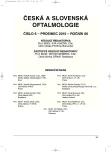Corneal Higher Order Aberrations and their Changes with Aging
Authors:
S. Čermáková; Š. Skorkovská
Authors‘ workplace:
Klinika nemocí očních a optometrie LF MU a Fakultní nemocnice u svaté Anny, Brno, přednosta doc. MUDr. Svatopluk Synek, CSc.
Published in:
Čes. a slov. Oftal., 66, 2010, No. 6, p. 254-257
Category:
Original Article
Overview
Cornea is the most important refractive medium of the eye and affects its total aberration state. This paper deals with corneal higher order aberrations in healthy humans and evaluates their changes with aging and corneal curvature. The influence of the corneal anterior and posterior surfaces on aberrations of the whole cornea was also investigated. The examination was performed with a Scheimpflug camera which enables to examine the anterior and posterior corneal surface separately. The results show that higher order aberrations of the whole cornea are influenced mainly by the anterior surface aberrations. The main corneal higher order aberration is the Z(4,0) spherical aberration which has a positive value and increases with age. Also, 3rd order aberration values are of importance, especially coma which also increases with age. As a consequence, the root-mean-square of the 3rd and 4th order aberrations in elderly people has a higher value.
Key words:
cornea, higher order aberrations, Scheimpflug camera, age
Sources
1. Oculus Pentacam/Pentacam HR: Instruction manual/User guide.
2. Amano, S., Amano, Y., Yamagami, S. t al.: Age-related changes in corneal and ocular higher-order wavefront aberrations. Am J Ophthalmol, 004, 137: 988–92.
3. Applegate, R.A., Marsack, J.D., Ramos, R. et al.: Interaction between aberrations to improve or reduce visual performance. J Cataract Refract Surg, 2003, 29: 1487–95.
4. Applegate, R.A.: Glenn Fry award lecture 2002: wavefront sensing, ideal corrections, and visual performance. Optom Vis Sci, 004, 81: 167–77.
5. Artal, P., Berrio, E., Guirao, A. et al.: Contribution of the cornea and internal surfaces to the change of ocular aberrations with age. J Opt Soc Am A Opt Image Sci Vis, 2002, 19: 137–43.
6. Atchison, D.A.: Higher order aberrations across the horizontal visual field. J Biomed Opt. 2006; 11(3): 34026. Erratum in: J Biomed Opt, 2006, 11: 059801.
7. Buehren, T., Collins, M.J., Carney, L.G.: Near work induced wavefront aberrations in myopia. Vision Res, 005, 45: 1297–312.
8. Collins, M.J., Buehren, T., Bece, A. et al.: Corneal optics after reading, microscopy and computer work. Acta Ophthalmol Scand, 2006, 84: 216–24.
9. Feuermannová, A., Komenda, I., Rozsíval, P.: Wavefront analýza – nový směr v éčbě a vyšetřování refrakčních vad, 37–60. In: Trendy soudobé oftalmologie – svazek 4. Galén, Praha 2007, 325 s.
10. Fujikado, T., Kuroda, T., Ninomiya, S. t al.: Age-related changes in ocular and corneal aberrations. m J Ophthalmol, 004, 138: 143–6.
11. Guirao, A., Redondo, M., Artal, P.: Optical aberrations of the human cornea as a function of age. J Opt Soc Am A Opt Image Sci Vis, 000, 17: 1697–702.
12. Jahnke, M., Wirbelauer, C., Pham, D.T.: Influence of age on optical aberrations of the human eye. Ophthalmologe, 2006, 103: 596–604.
13. Kawamorita, T., Handa, T., Uozato, H.: Changes of corneal aberrations in sitting and supine positions. Am J Ophthalmol, 2006, 141: 412–4.
14. Koh, S., Maeda, N., Hirohara, Y. et al.: Serial measurements of higher-order aberrations after blinking in normal subjects. Invest Ophthalmol Vis Sci, 2006, 47: 3318–24.
15. Llorente, L., arbero, S., ano, D. et al.: Myopic versus hyperopic eyes: axial length, corneal shape and optical aberrations. J Vis, 004, 4: 288–98.
16. Montés-Micó, R., Alko, J.L., MuĖoz, G. et al.: Postblink changes in total and corneal ocular aberrations. Ophthalmology, 004, 111: 758–67.
17. Oshika, T.: Quantitative assessment of quality of vision. Nippon Ganka Gakkai Zasshi, 004, 108: 770–808.
18. Wang, L., Dai, E., Koch, D.D. et al.: Optical aberrations of the human anterior cornea. J Cataract Refract Surg, 003, 29: 1514–21.
19. Yeh, L.K., Chiu, C.J., Fong, C.F. et al.: The genetic effect on refractive error and anterior corneal aberration: twin eye study. J Refract Surg, 2007, 23: 257–65.
Labels
OphthalmologyArticle was published in
Czech and Slovak Ophthalmology

2010 Issue 6
Most read in this issue
- Corneal Higher Order Aberrations and their Changes with Aging
- Corneal Cross-linking – Modern Method of Keratoconus Treatment
- Deep Perforating Trabeculectomy – Results after up to Six Years Follow-Up
- Improvement in the Outcome of Visual Impairment using Low Vision Aids in Children
